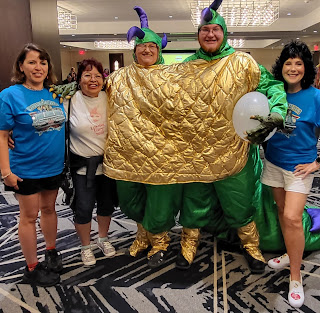
Dedicated Lucy Fans
Sue, Jessie, Jessica and Sandy
Look for them at Lucy Fest 2024. They won't be hard to spot .. just look for their Lucy attire and their warm Lucy smiles.
The following paragraphs were published in the Chautauqua Gazette on Monday July 29, 2024 with the title, Lucy Fans and Their Love of Lucy.
Three ladies named Sue, Jessica and Sandy. Who are they? They are Lucy fans who have been coming to Jamestown for many years to celebrate their mutual admiration and love of Lucille Ball, known to the world as simply, Lucy. They represent St. Louis, Missouri; Palmdale, California and Edwards, Illinois. Jessica's mother, Jessie, joined her last year and has now met her daughter's "Lucy family". Jessica has been going to every Lucy Fest since celebrating Lucy's 100th birthday and being among the 915 Lucy red-lipsticked, red-headed look-alikes gathered in downtown Jamestown on August 6, 2011 to set the first Guinness World Record in her honor as the "Most People Dressed as Lucy Ricardo in One Place at One Time".
Just Some of the Lucy Look-Alikes!
The Two-Headed Dragon
from
I Love Lucy Episode #17
Season 5
Lucy Goes to Scotland
Episode directed by James V. Kern
Originally aired on CBS-TV on February 20, 1956
A popular event was a costume contest during the masquerade ball held in the time-honored ballroom of the Jamestown Hotel. Sandy and her son, Matthew won the costume contest in 2014.
Palmdale, California
Jessica
Jessica and Her Mom, Jessie
Jessie
Sandy
Sandy visited Jamestown for the first time in August of 2017. Since then she and her son, Matthew have made 14 trips, by car from the Peoria, Illinois area. Sandy and Jessica participate in a festival favorite, the trivia contest every year and continue to do quite well as the questions get more difficult until a grand winner is chosen among the contestants. I think the winner can almost recite word-for-word dialogue from any I Love Lucy episode.
Sue
Sue and Jessica on the Famous I Love Lucy Set
Living Color!
Lucy Fans in the I love Lucy kitchen!
Jessica and Sue
"You Said a Mouthful"
Takin' a Break @ Lucy Fest
The Lucy Gang at the Sheldon House
Jessie, Jessica, Sue, Sandy and Matthew
Lucy! We're Home!
This Lucy Gang Represents
California! Missouri! and Illinois!



.jpg)














































